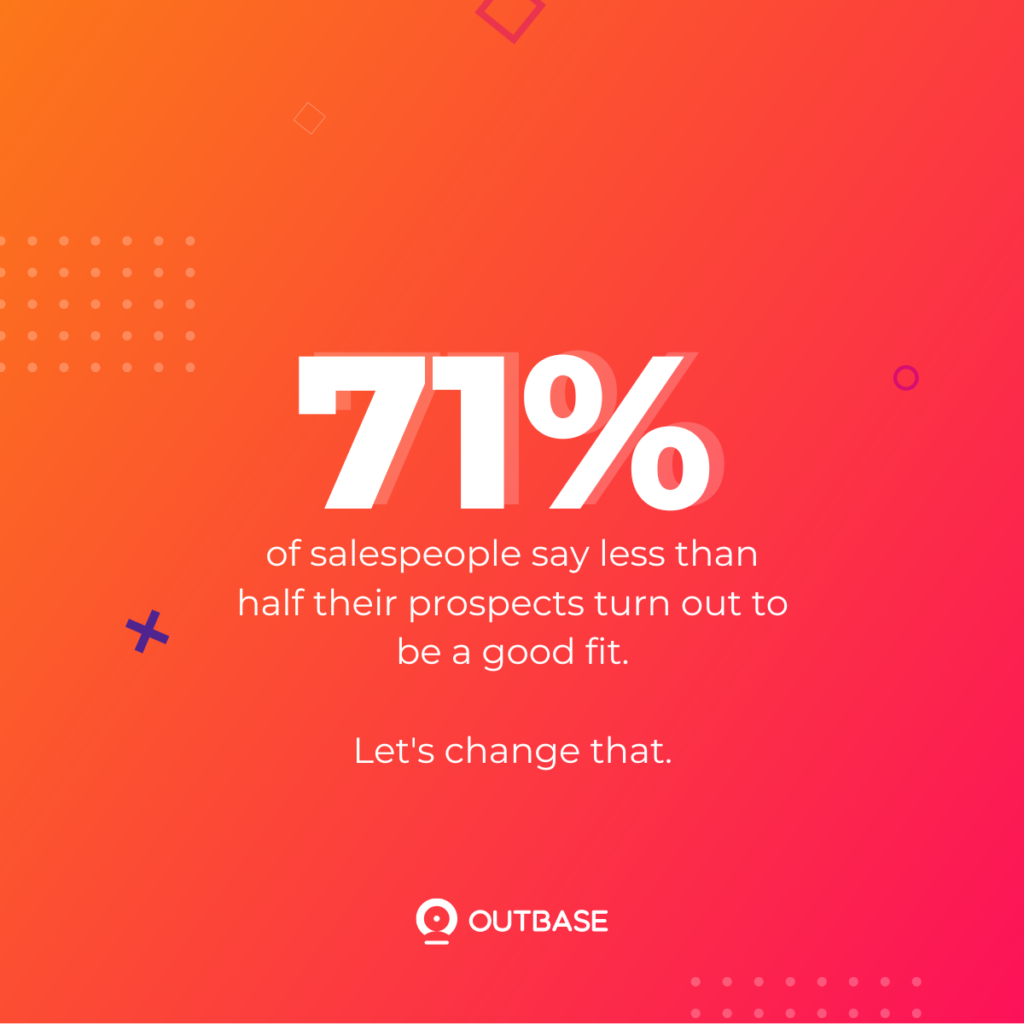Outbase will be closing down from 31st October 2024. Thanks for your support along the way, if you have any questions please contact us before then on the chat below


We all love that feeling of going on holiday. Stepping off that plane and letting the hot air hit you, sipping piña coladas by the pool… What’s not so lovable is the waiting and the frugal months before. But saving up money is essential in order for you to be able to go on that holiday (unless you’re Richard Branson).
A bit like saving up for a holiday, sales prospecting has nowhere near as much of a buzz as closing an actual sale does. But it is an essential part of the process to get to that point.
If you fear sales prospecting, then not to worry – you’re not alone. Many sales professionals also struggle with prospecting:
You’re probably wondering why. The simple answer? They just aren’t getting in front of the right customers in the first place. Here are some statistics that prove how beneficial sales prospecting can be when you are prospecting leads who are the best fit for your brand:
So how do we get in front of the right customers? Firstly you’re going to need to take the time and effort to truly understand your prospects. Sales prospecting may seem tedious, but will always end up being more rewarding than just taking a shot in the dark targeting random leads. Without much further ado, here is our guide to improving lead quality through sales prospecting.
Firstly, you need to figure out who it is you want to sell to. You may think you already know fine well who you are selling to. But what we are talking about here are your most successful customers; your ideal customers.
The best way to target these guys is to establish an ideal customer profile (ICP) – a fictitious company which embodies all the qualities that make them the most fitting customer for your brand.
Also, you could create a buyer persona. While your ICP acts as a model of the company you are aiming to sell to, your buyer persona characterises the buying patterns of companies who fit within your ICP. Personas are semi-fictional depictions of your ideal customers, curated using real data and research on your existing customers and details the demographics, goals, motivators and challenges which face them.
Research into your prospects will allow you to understand their individual needs and goals, and therefore identify who are quality leads. Additionally, by using information gathered from your research in your prospecting efforts, the prospect will acknowledge that you have taken the time to get to know them.
This information will allow you to tailor your pitch to your prospect’s individual, current needs. By proving that you understand their needs, you qualify yourself as an appropriate solution to their problem, which will ultimately push them down the sales funnel.
Avoiding social media is now a huge risk to businesses. 91% of B2B buyers are now active on social media. If you lack a social media presence, then you run the risk of competitors getting to your prospects before you do.
Building a strong social media profile will enable you to interact with prospects at different stages of their buyer journey. Engagement is one of the key features of any social media platform, so it’s vital to make the most of this to establish a presence in the prospect’s mind.
Through engaging with leads and prospects in the early stages of the buying journey, it will act as a great soft opener and begin to build a valuable relationship with them.
Albeit a traditional technique, email still comes out on top in terms of sales prospecting, with 80% of buyers admitting that they prefer to be contacted via email by sellers.
However, typical mass-sent emails are now a thing of the past and personalised content is king in the email world, with a 26% higher open rate than bulk emails. Through using the information you will have gathered from your research on the prospect, you can personalise and tailor your message to their specific needs.
Okay, maybe expert is a bit of a stretch. But you really should get to know the prospect enough that you seem like an expert to them. 51% of top sales prospectors are perceived as experts in the lead’s particular industry.
Additionally, as well as knowing everything about their industry, you must also ensure you are listening to the prospect. Talk too much and risk driving them away due to information overload and not feeling listened to. Poor performers are found to chatter away for more than 68% of the call, making it hard for the prospect to fit a word in sideways!
So you have generated all these high quality leads, carried out a tonne of research, and carefully curated personalised emails. Then, conversations start to pick up.
This is not something that you can just take personal note of and remember off the top of your head. This information needs to be stored in a highly organised manner, which can be done with the use of a centralised CRM system.
Every conversation you book should be logged in this CRM, which everyone in your company should have access to. This access is important as it will avoid any two people in your company from targeting the same customer. You should log every single piece of information from conversations immediately, before things quickly become forgotten.
Every note, every booking, and every small detail the prospect has mentioned should be registered. Doing this makes conversations feel much more personal with your prospect and will improve your chances to convert.
Having relevant content at each stage of the sales funnel will guide your prospect closer to conversion.
Essentially, the content you send your prospects must relate directly to whatever stage they are currently at in their buyer journey. We get that you’re desperate for these leads to convert as it will be a huge benefit to your company, but whatever you do, you must avoid making it all about yourself.
The focus of your content should really be placed on the consumer. 69% of consumers rank content which speaks to them directly as important.
Through distributing relevant and targeted content throughout the sales funnel, the prospect will process these cues and move closer towards the purchasing stage.
Try not to get disappointed if you don’t get a response immediately. 95% of leads need time to mature and will not convert immediately. Chances are, the people you are targeting are very busy people, so allow some time for them to get back to you. If there is still no reply after a while, you should consider sending them a follow-up email.
This analysis discovered that response rates actually increase following the first email, and remains above average for the third email. Sometimes, all your prospect needs is a gentle reminder of your first email to encourage them to get back to you. You also don’t want to bombard them with messages and should instead space out your emails to avoid coming across as intrusive. We recommend leaving a gap of 6-8 days.
Asking for referrals is an efficient and simple way of generating more leads. If you are already utilising prospecting to connect with high quality leads, then the chances are that if you ask them for referrals then they will refer you to more high quality leads who are a good fit for your brand and are ready to buy.
For this reason, referrals tend to convert at a quicker rate and require less prospecting. 69% of B2B companies reported a quicker close time on sales opportunities from referrals. They are also lower cost to acquire, are likely to have more trust in your brand, and have a better retention rate.

If sales prospecting feels like a task to you, then question yourself: “am I targeting the best leads for my business?”
Chances are, you may need a slight change of direction. The above guide will assist you in identifying and generating higher quality leads who are more fitted to your brand, and how to help these leads move through the sales funnel with the use of relevant content, personalised emails, and a surplus of information about their goals and challenges.
That might sound like a lot of information, but we can help. At Outbase are well equipped to take some of the pressure off and do some of this work for you.
We can help personalise and informalise your emails to add that all-important human touch, and also assist in feeding leads personalised content throughout their buyer journey using automation. If you are interested in any assistance with your sales prospecting efforts, feel free to get in touch with us and we will sort out a chat!
Or sign up here.